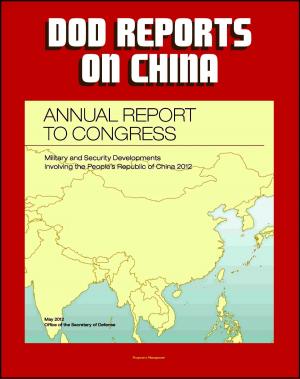National Defense Intelligence College Paper: Beneath the Surface - Intelligence Preparation of the Battlespace for Counterterrorism - bin Laden, al-Qaida, Jihad, Horn of Africa, Hezbollah
Nonfiction, History, Military, Strategy, Social & Cultural Studies, Political Science| Author: | Progressive Management | ISBN: | 9781311314468 |
| Publisher: | Progressive Management | Publication: | December 6, 2013 |
| Imprint: | Smashwords Edition | Language: | English |
| Author: | Progressive Management |
| ISBN: | 9781311314468 |
| Publisher: | Progressive Management |
| Publication: | December 6, 2013 |
| Imprint: | Smashwords Edition |
| Language: | English |
This unique and informative paper was produced by the National Intelligence University / National Defense Intelligence College. Topics and subjects include: terrorism, Usama bin Laden, al-Qaida, COA, COG, jihad, Horn of Africa, FARC, GSPC, hezbollah, HUJI, IIPB, IRA, JI, mission analysis, HUMINT, SIGINT, IMINT, COMINT, terrorist group types, OCOKA, Afghanistan, Iraq, terrain zones, JIPB, JFIC, JMIC, JWAC, LTTE, NASIC, open systems model, violent systems model, universal model, system properties, functional analysis systems technique (FAST), red teaming.
Major Thomas' Beneath the Surface comes at precisely the right time in the War on Terrorism. Over the past three years the U.S. military and other instruments of national power have been able to attack and damage Usama Bin Laden's al-Qaida network. The remainder of the War or Terrorism—which will continue for years— requires that intelligence be on the front. The War has been, and will continue to be, an intelligence war. In such a war intelligence and operations are not separate staff components; they are instead a blend of activities that are mutually reinforcing. In this continuing war every soldier is a collector, and every collector is a soldier; operators glean intelligence directly from the field, and intelligence is always operational. Further, the war ahead will demand new strategies for long-term success. The counterpunching phase is over. The rapid-fire operations-intelligence, counterterrorism-targeting cycle happening right now in Iraq and Afghanistan—the "find, fix, finish, exploit, then find again" process—becomes less powerful as the campaign continues. This cycle has to be underpinned by a strategic intelligence framework that ensures we are attacking a part of the enemy that matters—not just taking the near-term opportunity that inflicts little lasting damage.
The U.S. requires new strategies to collect intelligence, to manufacture new intelligence (using operations in doing so), and most importantly to organize data in new, systemic and strategic ways to make the most of what we know about this shadowy, self-healing and determined asymmetric, worldwide adversary.
In my view Major Thomas' work is one of the first coherent blueprints for the way ahead. For persons seeking to understand the complexity of terrorist violence, Chapter One provides a broad and comprehensive overview for thinking about the problem. For the counterterrorism practitioner, Chapters Two through Five are extraordinarily well-reasoned views on organizing data to maximize knowledge and potential power. Major Thomas also offers sound advice on leveraging well-organized intelligence data to derive effective courses of action and to focus operational activity for maximum effect.
Chapter 1 * COUNTERING TERRORISTS * Approach * Violent Theater * Violent Intellectuals * Terror's Bad Name * Innocence Lost * Fixing on Groups * Hybrid Adversary * Counterterrorism * Mission Analysis I * The Big Picture * Campaigning * Face-to-Face * Asymmetric Contests * Preparing the Battlespace * Four Phases * Three Levels * Linking Concepts * Parting Shots * Chapter 2 * TERROR'S SPACE * Lost in Space * Mission Analysis II * Getting it Done * Setting Limits * Going Three-Dimensional * What we Know and Don't Know * Remodeling Space * Mapping Stakeholders * Dimensional Sectors. * Positioning Players * Nested Characteristics * Urban Battlespace * Parting Shots * Chapter 3 * BATTLESPACE EFFECTS * Special Effects * Effects * Courses of Action * Step-by-Step * Total Effects * Net Effects * Dimensional Effects * Cumulative Effects * Parting Shots * Chapter 4 * EVALUATING CAPABILITIES * Adversary Capabilities * Centers of Gravity * Old Models * The Real World * Can Do * Full Spectrum Capabilities * Agents of Influence * Supermodels
This unique and informative paper was produced by the National Intelligence University / National Defense Intelligence College. Topics and subjects include: terrorism, Usama bin Laden, al-Qaida, COA, COG, jihad, Horn of Africa, FARC, GSPC, hezbollah, HUJI, IIPB, IRA, JI, mission analysis, HUMINT, SIGINT, IMINT, COMINT, terrorist group types, OCOKA, Afghanistan, Iraq, terrain zones, JIPB, JFIC, JMIC, JWAC, LTTE, NASIC, open systems model, violent systems model, universal model, system properties, functional analysis systems technique (FAST), red teaming.
Major Thomas' Beneath the Surface comes at precisely the right time in the War on Terrorism. Over the past three years the U.S. military and other instruments of national power have been able to attack and damage Usama Bin Laden's al-Qaida network. The remainder of the War or Terrorism—which will continue for years— requires that intelligence be on the front. The War has been, and will continue to be, an intelligence war. In such a war intelligence and operations are not separate staff components; they are instead a blend of activities that are mutually reinforcing. In this continuing war every soldier is a collector, and every collector is a soldier; operators glean intelligence directly from the field, and intelligence is always operational. Further, the war ahead will demand new strategies for long-term success. The counterpunching phase is over. The rapid-fire operations-intelligence, counterterrorism-targeting cycle happening right now in Iraq and Afghanistan—the "find, fix, finish, exploit, then find again" process—becomes less powerful as the campaign continues. This cycle has to be underpinned by a strategic intelligence framework that ensures we are attacking a part of the enemy that matters—not just taking the near-term opportunity that inflicts little lasting damage.
The U.S. requires new strategies to collect intelligence, to manufacture new intelligence (using operations in doing so), and most importantly to organize data in new, systemic and strategic ways to make the most of what we know about this shadowy, self-healing and determined asymmetric, worldwide adversary.
In my view Major Thomas' work is one of the first coherent blueprints for the way ahead. For persons seeking to understand the complexity of terrorist violence, Chapter One provides a broad and comprehensive overview for thinking about the problem. For the counterterrorism practitioner, Chapters Two through Five are extraordinarily well-reasoned views on organizing data to maximize knowledge and potential power. Major Thomas also offers sound advice on leveraging well-organized intelligence data to derive effective courses of action and to focus operational activity for maximum effect.
Chapter 1 * COUNTERING TERRORISTS * Approach * Violent Theater * Violent Intellectuals * Terror's Bad Name * Innocence Lost * Fixing on Groups * Hybrid Adversary * Counterterrorism * Mission Analysis I * The Big Picture * Campaigning * Face-to-Face * Asymmetric Contests * Preparing the Battlespace * Four Phases * Three Levels * Linking Concepts * Parting Shots * Chapter 2 * TERROR'S SPACE * Lost in Space * Mission Analysis II * Getting it Done * Setting Limits * Going Three-Dimensional * What we Know and Don't Know * Remodeling Space * Mapping Stakeholders * Dimensional Sectors. * Positioning Players * Nested Characteristics * Urban Battlespace * Parting Shots * Chapter 3 * BATTLESPACE EFFECTS * Special Effects * Effects * Courses of Action * Step-by-Step * Total Effects * Net Effects * Dimensional Effects * Cumulative Effects * Parting Shots * Chapter 4 * EVALUATING CAPABILITIES * Adversary Capabilities * Centers of Gravity * Old Models * The Real World * Can Do * Full Spectrum Capabilities * Agents of Influence * Supermodels















